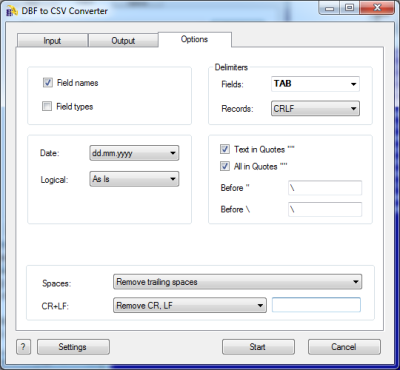

Please don’t forget to Accept Answer and Yes for "was this answer helpful" wherever the information provided helps you, this can be beneficial to other community members.The Excel to Text Converter is a newer version of the Batch Excel To CSV Converter Application which works on Windows & Mac. Please do share the feedback link once it is posted so that I can share it with internal team to further review it.
#Excel to csv converter batch update#
Or you can copy with the current behavior and have a custom application or custom program that can do a bulk update on the file names in a specified folder.Īs this is a product functionality related ask, if you have any additional feedback or a new feature request I would high encourage you to please log it IDEAS forum here: All the feedback shared in this forum are actively monitored and reviewed by respective product owners. Workaround: Workaround is to use GetMetada and ForEach to update the file names with different extension when copying. The is expected behavior from recursive feature. Just wanted to let you know that if we use recursive feature in Copy activity, not only Excel file any file from source will be copied as is with same file name and incase if you specify a different extension on the sink data set settings, then the new file extension will be appended to the original file (for eg: source file name - abc.txt and sink file name will be ). Please don’t forget to Accept Answer and Yes for "was this answer helpful" wherever the information provided helps you, this can be beneficial to other community Bajaj Please do let us know if you have further questions. The item() function is used here to refer to the current file being processed by the "ForEach" activity. The output CSV files will have the correct file extension of. This expression will replace the ".xlsx" extension with ".csv" in the output file name. Specify the "sink file name" property as '.xlsx', '.csv') to specify the destination CSV file name. In the "Copy Data" activity, specify the "source file name" property as item().name to specify the source Excel file. Inside the "ForEach" activity, add a "Copy Data" activity to copy each Excel file to a CSV file with the same name.In the "ForEach" activity, specify the Items property as Metadata').output.childItems. Next add a subsequent ForEach activity to your pipeline and configure it to loop through the list of Excel files retrieved by the "Get Metadata" activity.Make sure to select below Field list properties in your GetMetada activity configuration. For example, if your files are located in a folder called "input" in your Azure Storage account, you can specify the path as "input/". In the "Get Metadata" activity, specify the path to the folder containing the Excel files. First add a Get Metadata activity to your pipeline to retrieve the list of Excel files in the source folder.Before using the foreach activity you will have to use a GetMetadata activity to get the list of fileNames which you will be passing them to your source dataset and sink dataset dynamically for each iteration of the copy activity. xlsx file extension in your file name, instead of using recursive feature, you can use the ForEach activity to loop through the list of files and use the "source" and "sink" properties of the Copy Data activity to specify the source and destination file paths. This is the reason why you are seeing the original file name appended with. Please note that when you use recursive feature in copy activity, copy activity will copy all the files as per your source dataset configuration as is and will append any file extension specified in the sink dataset configuration. Welcome to Microsoft Q&A forum and thanks for reaching out here.Īs per my understanding, you are using "recursive": true to copy multiple Excel files to your sink but changing the file extension from.


 0 kommentar(er)
0 kommentar(er)
